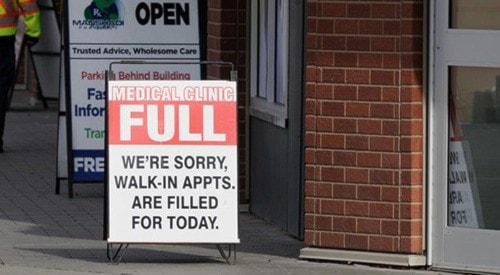By Dale Bass
Kamloops This Week
Health Minister Terry Lake is hoping two new walk-in clinics will be open for patients by January.
The clinics — one in the North Shore Health Centre at 370 Tranquille Road, and the other in the former YMCA/YWCA space in Northills Centre — will be turn-key operations, Lake said, ready for medical staff to start work and not have to set up their clinic.
It’s part of a four-point strategy Lake announced at the mall yesterday, one designed to address the lack of family physicians in the city and, in particular, on the North Shore.
It’s anticipated the two clinics will bring from five to seven doctors to Kamloops.
Other steps include enhanced targeted recruitment of family doctors and a new nurse-in-practice program to increase capacity at existing offices and clinics. There will also be recruitment of doctors from the province’s practice-ready primary-care centres.
The recruitment plan would see the program altered from the way it works now. It was designed to link doctors trained and certified in other countries with B.C. doctors until they’re familiar with the system in the province. They are then set up in rural areas that need more general practitioners.
For Kamloops, Lake said, the plan is to recruit five from the program and bring them to the city. Nurse-practitioners will also be recruited.
Community-care teams will also be established to focus on frail elderly patients with complex medical conditions and for those with mental-health and substance-use concerns. The clinic for seniors will be at the mall location; the mental-health and substance abuse clinic will be at the Tranquille location.
Lake said the issue of seniors and their health concerns will be addressed immediately as work begins on the new clinics.
The Interior Health Authority will be establishing a protocol for them to get linked to the services they require quickly.
A special HealthLink BC phone number will also be established for Kamloops.
Seniors and other people looking for a family doctor can call it. Those looking for a doctor will be put on a wait list and, once a primary-care practice opens, be referred.
Seniors will be triaged over the phone by the nurses answering the line and given referrals to services.
It’s expected phone number will be in place by the end of the month.
Calling the situation in Kamloops unique, Lake said the plan is the result of collaboration between his ministry, Doctors of B.C., the Interior Health Authority and the Kamloops Division of Family Practice.
If the program works here, Lake said, it could provide a template for other larger communities struggling with a declining number of family physicians.
It could also see a similar clinic opened on the South Shore next year.
Changing ways of practising medicine
Would-be doctors are learning to practise medicine in a way that is different from past generations of graduates, said Chris Mazurkewich, CEO of the Interior Health Authority — and it’s helping define how the provision of medicine will move forward.
Two general practitioners — doctors Wayne Dong and Sher Muhammad — are closing their Tranquille Medical Centre practices this month and the likelihood is that interdisciplinary care will fill the gap.
Medical students are taught to provide team-based care, Mazurkewich said, and it’s what many of the graduates of UBC want to do when they complete their studies and begin their careers.
Dr. Chip Bantock, chairman of the Kamloops Division of Family Practice board, outlined his own work day at last weeks press conference to announce changes to the health care in Kamloops.
His day started with rounds at Royal Inland Hospital, then he headed to his practice to see patients. He left at 9:45 a.m. to take part in the 10 a.m. press conference and, once it was completed, would return to his practice, seeing patients during his lunch hour due to the break in the morning, attend a meeting tonight and, eventually, go home.
New doctors see other benefits in the interdisciplinary team approach, Mazurkewich said.
It provides one point of contact for several health resources, shares the costs — which is important because many graduate with substantial student-loan debt — and gives balance in the amount of time they must put into seeing each patient.
Earlier this year, a retired doctor, Mark Fromberg, told the province’s Select Standing Committee on Health that the province needs to make it easier for general practitioners to create interdisciplinary teams of medical professionals.
Fromberg said there are too many barriers.
If that could be resolved, the team approach could help resolve the doctor crisis, he said, because other medical professionals could deal with their own specific area of health care with patients, leaving the GP free to deal with those who really need to see a doctor.
